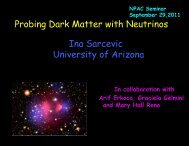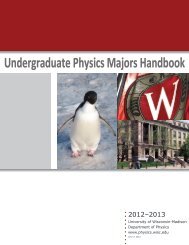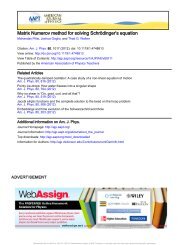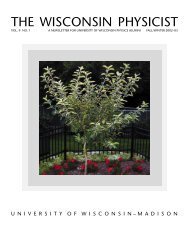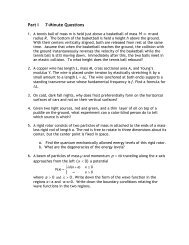Vol. 15 No. 1, 2009 - Department of Physics - University of ...
Vol. 15 No. 1, 2009 - Department of Physics - University of ...
Vol. 15 No. 1, 2009 - Department of Physics - University of ...
Create successful ePaper yourself
Turn your PDF publications into a flip-book with our unique Google optimized e-Paper software.
The Wisconsin Physicist 19<br />
Roger will be deeply missed by his<br />
wife <strong>of</strong> more than 50 years Betty<br />
Lindsey Perkins, daughters Martha<br />
Perkins, Ann Perkins, and Elaine<br />
Perkins Jacobs, son-in-law Brian<br />
Jacobs, grandchildren Lindsey (Lindy)<br />
and John (Johnny) Jacobs and James<br />
Coburn, his sister Priscilla Bath,<br />
and nephew David Bath and wife<br />
Dreana and son Steven, and nephew<br />
Dale Bath and wife Lynn, as well as<br />
numerous friends.<br />
Victor Vacquier Sr.<br />
January 11, <strong>2009</strong><br />
Victor Vacquier Sr., pr<strong>of</strong>essor<br />
emeritus <strong>of</strong> geophysics<br />
at Scripps Institution <strong>of</strong><br />
Oceanography, UC San Diego, died<br />
Jan. 11, <strong>2009</strong>, in La Jolla, Calif., from<br />
pneumonia. He was 101 years old.<br />
Vacquier’s distinguished science<br />
career included the invention <strong>of</strong> the<br />
fluxgate magnetometer and airborne<br />
and marine magnetic surveying,<br />
which led to the discovery <strong>of</strong><br />
magnetic field patterns preserved in<br />
the seafloor.<br />
In 1957, Vacquier joined Scripps as<br />
a research physicist to direct the<br />
geomagnetics program in the Marine<br />
Physical Laboratory (MPL). In 1962<br />
became a pr<strong>of</strong>essor <strong>of</strong> geophysics at<br />
Scripps. During his oceanographic<br />
career, Vacquier led numerous oceangoing<br />
expeditions to obtain records<br />
<strong>of</strong> Earth’s magnetic field in the three<br />
major oceans and to measure and<br />
map the flow <strong>of</strong> heat outward from<br />
the seafloor.<br />
His pioneering research to map<br />
magnetic field patterns along the<br />
seafloor established that vast tracks<br />
<strong>of</strong> the oceanic crust in the eastern<br />
Pacific were <strong>of</strong>fset at long linear<br />
fracture zones. His work in the<br />
western Pacific revealed that marine<br />
magnetic anomalies were <strong>of</strong>fset by<br />
1,250 kilometers (776 miles) across a<br />
fracture zone and was a key factor for<br />
the rapid acceptance <strong>of</strong> the theory <strong>of</strong><br />
plate tectonics in the mid 1960s.<br />
In the early 1960s Vacquier took over<br />
the shipboard measurement program<br />
for oceanic heat flow at Scripps.<br />
He and colleagues found evidence<br />
for elevated heat flow through the<br />
seafloor at the crest <strong>of</strong> the Mid-<br />
Atlantic Ridge and the Central Indian<br />
Ridge. In the extensive deep basins<br />
<strong>of</strong> the western Pacific and the eastern<br />
Indian Ocean he confirmed that the<br />
heat flow was nearly uniform and<br />
much lower than that at the midocean<br />
ridges. Such measurements<br />
reinforced the principles <strong>of</strong> seafloor<br />
spreading and led to the now widelyaccepted<br />
thermal models <strong>of</strong> the<br />
oceanic lithosphere.<br />
Vacquier was born in St. Petersburg,<br />
Russia, on Oct.13, 1907. In 1920,<br />
following the Russian Revolution, he<br />
and his family escaped across the<br />
frozen Gulf <strong>of</strong> Finland to Helsinki on a<br />
one-horse sleigh. He and his mother<br />
immigrated to the United States in<br />
1923.<br />
Vacquier received a bachelor’s<br />
degree in electrical engineering from<br />
the <strong>University</strong> <strong>of</strong> Wisconsin in 1927<br />
and a master’s degree in physics in<br />
1929. He worked for Gulf Research<br />
in Pittsburgh, where in 1940 he<br />
invented the fluxgate magnetometer.<br />
The instrument was used on a blimp<br />
and then on an airplane to detect<br />
submarines during World War II. The<br />
method was later applied to airborne<br />
exploration for oil and minerals.<br />
From 1944 to 1953 he worked for<br />
Sperry Gyroscope, Inc., where he<br />
developed the Mark 19 and Mark 23<br />
gyrocompasses, standard equipment<br />
on all Navy ships for at least 30 years<br />
to measure the direction <strong>of</strong> true<br />
north. From 1953 to 1957 he worked<br />
at the New Mexico Institute <strong>of</strong> Mining<br />
and Technology where he developed<br />
an electrical conductivity method to<br />
prospect for groundwater.<br />
Vacquier’s active research career<br />
spanned more than seven decades<br />
and included more than 50 scientific<br />
publications and 18 patents. He<br />
received numerous honors for his<br />
pioneering work in geophysics. In<br />
1960, he was awarded the Wetherill<br />
Medal <strong>of</strong> the Franklin Institute for<br />
his development <strong>of</strong> the magneticairborne<br />
detector and its application<br />
to geophysical prospecting for<br />
oil and minerals. He received<br />
the 1963 Albatross Award <strong>of</strong> the<br />
American Miscellaneous Society<br />
for “having displaced the seafloor<br />
by 700 kilometers,” the John Adam<br />
Fleming Medal from the American<br />
Geophysical Union in 1973 for “<br />
original research and technical<br />
leadership in geomagnetism.” In<br />
1976, he received the Society <strong>of</strong><br />
Exploration Geophysicists’ Fessenden<br />
Award in recognition <strong>of</strong> his invention<br />
<strong>of</strong> the airborne magnetometer and<br />
in 1995 received the Alexander<br />
Agassiz Medal from the U.S.<br />
National Academy <strong>of</strong> Science for his<br />
contributions to geomagnetism and<br />
tectonics.<br />
He is survived by his wife Mihoko<br />
Vacquier <strong>of</strong> La Jolla, Calif., his<br />
son Victor D. Vacquier, a Scripps<br />
pr<strong>of</strong>essor, and daughter-in-law<br />
Judith Vacquier <strong>of</strong> La Jolla, Calif.,<br />
four grandchildren and four great<br />
grandchildren.<br />
Frank Shoemaker<br />
February 11, <strong>2009</strong><br />
Frank Shoemaker, a leader in the<br />
development <strong>of</strong> high-energy<br />
particle accelerators during<br />
a highly revelatory era for physics<br />
and a founding member <strong>of</strong> the<br />
experimental particle physics group<br />
at Princeton, has died at age 86.<br />
Shoemaker, a pr<strong>of</strong>essor emeritus<br />
<strong>of</strong> physics, a mentor to generations<br />
<strong>of</strong> junior faculty and graduate<br />
students, and a dedicated teacher<br />
who designed many <strong>of</strong> the<br />
<strong>University</strong>’s freshman physics class<br />
demonstrations, died at Meadow<br />
Lakes in Hightstown, N.J., on Feb. 11.


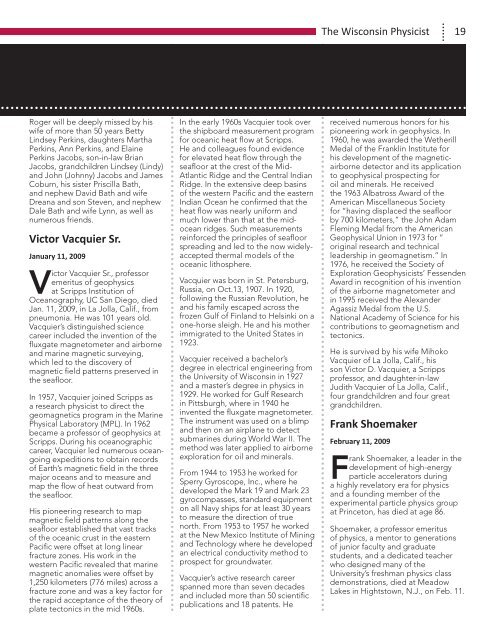

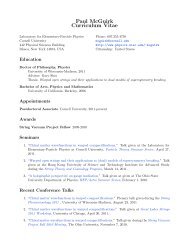
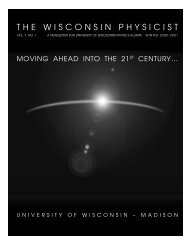
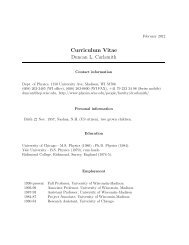
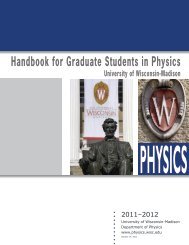

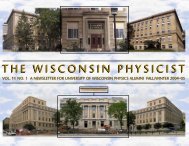

![The Symmetric Linear Potential [ ]](https://img.yumpu.com/25329322/1/190x245/the-symmetric-linear-potential-.jpg?quality=85)
